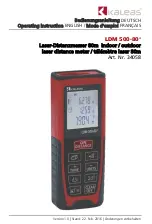
User Manual SM6026
86
The CORRection:SPOT<n>:STATe command is used to set the state of some specific frequency spots.
The CORRection:SPOT<n>:STATe query returns the current state of each frequency spot (FREQ 1,
FREQ 2 or FREQ 3).
Command syntax:
ON
CORRection:SPOT<n>:STATe
OFF
1
0
Where,
1 (decimal 49) is equal to ON.
0 (decimal 48) is equal to OFF.
<n>:
1 refers to frequency spot 1.
2 refers to frequency spot 2.
3 refers to frequency spot 3.
For example: WrtCmd (“CORR:SPOT1:STAT ON”)
Query syntax: CORRection:SPTO<n>:STATe?
Return format: <NR1><NL^END>
The CORRection:SPOT<n>:FREQuency command is used to set the frequencies of frequency spots1, 2
and 3. The CORRection:SPOT<n> query returns the current frequency of specific frequency spot.
Command syntax: CORRection:SPOT<n>:FREQeuency<value>
Where,
<value> can be NR1, NR2 or NR3 data format followed by HZ, kHz and MHZ.
<n>:
1 refers to frequency spot 1.
2 fefers to frequency spot 2.
3 refers to frequency spot 3.
For example: WrtCmd (“CORR:SPOT1:FREQ 2KHZ”) Set the frequency of frequency spot 1 as 2KHZ.
NOTE: <value> should be ranged from 20HZ to 300KHZ (SM6026 A), or return format will report
errors.
Query syntax: CORRection:SPOT<n>:FREQuency?
Return format: <NR3><NL^END>
The CORRection:SPOT<n>:OPEN command is used to execute open correction for specific frequency
spots (frequency 1, frequency 2 and frequency 3).
Command syntax: CORRection:SPOT<n>:OPEN
Where,
<n>:
1 refers to frequency spot 1.
2 refers to frequency spot 2.
3 refers to frequency spot 3.
For example: WrtCmd (“CORR:SPOT1:OPEN”) Execute open correction for frequency spot 1.
The CORRection:SPOT<n>:SHORt command is used to execute short correction for specific frequency
spots (frequency 1, frequency 2 and frequency 3).
Command syntax: CORRection:SPOT<n>:SHORt










































